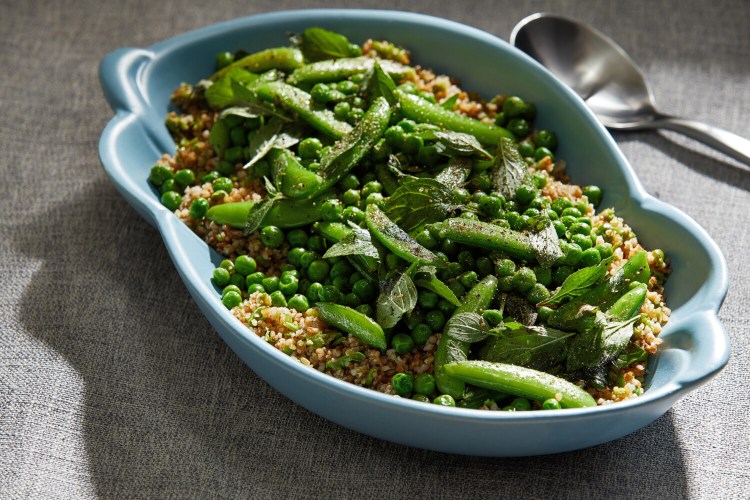I judge my spring garden by two metrics – how well I treated my peas and how well they’re treating me. Did I plant them at the right time – as soon as the soil can be worked in early spring? Did I keep enough of the birds and squirrels away to prevent the pilfering of those pea seeds before they had a chance to sprout and grow? And did I give them a trellis to climb as soon as their shoots were stretching their limbs in search of one?
This year, with so much more time at home – and needing gardening’s therapeutic qualities more than ever – I could answer yes to all of the above. But the one thing I’ve never been good at is succession planting, the artful spacing out of sowing that leads, theoretically at least, to an artful spacing out of harvesting.
You know where this is going: My peas did so well that they soon started dripping from the plants, seemingly all at the same time. This year, I’m growing sugar snap peas rather than English peas, because I want to be able to consume the pods, too, and because they are one of the vegetables that truly sold my husband on the glories of fresh-from-the-vine eating.
Most weekdays, I make us a big salad for lunch, mostly from the garden: lettuces and other greens, carrots, broccoli and now those sugar snaps. But at this rate, I can’t quite keep up with them, and we feel a little like Lucy and Ethel in the candy factory, so I went looking for recipes that would use them differently. I settled on a pilaf from chef Floyd Cardoz, who died this spring of complications from COVID-19. In his 2016 cookbook, “Flavorwalla,” Cardoz describes a familiar situation: “I wanted to create a showcase for a lot of peas: a pressing issue, since they were pouring out of my garden faster than I could cook them.” He uses English peas and sugar snaps, pureeing some and stirring them into an aromatic bulgur pilaf and sauteing the rest with butter and mint to pile on top.
If you don’t have access to fresh English peas, don’t fret: Frozen work just fine here. But there is no substitute for the sugar snaps. I love them so much in this treatment that every bite reminds me that, soon enough, the pace of harvesting them will slow to a trickle and spring will be over.
BULGUR PILAF WITH SPRING PEAS
Adapted from “Flavorwalla” by Floyd Cardoz. Artisan, 2016.
Active: 25 minutes | Total: 50 minutes
4 to 6 servings
Vibrant spring peas in two forms add texture, color and nutrition to this grain dish. Bulgur – parboiled cracked wheat – is a great warm-weather option, because it cooks by absorbing the hot broth while off the heat. You can use couscous instead, but it won’t have the same appealing toothsome quality.
Ingredients
1 tablespoon canola or other neutral oil
1/2 teaspoon cumin seeds
2 whole cloves
One (1-inch) piece cinnamon stick
1 bay leaf
1/2 medium yellow onion, finely chopped (3/4 cup)
1 tablespoon finely chopped fresh ginger
1 jalapeño pepper, stemmed, seeded and finely chopped (1 tablespoon)
2 cups medium-grind bulgur
2 cups homemade or low-sodium store-bought vegetable stock
1 teaspoon kosher salt, divided, plus more to taste
2 tablespoons unsalted butter (may substitute vegan butter, such as Miyoko’s or Earth Balance), divided
4 1/2 cups fresh or frozen peas (from two 10-ounce bags)
2 cups (about 6 ounces) sugar snap peas, strings removed
1 cup loosely packed fresh mint leaves
1/4 teaspoon freshly cracked black pepper, plus more to taste
Steps
In a 3- or 4-quart saucepan over medium heat, heat the oil until shimmering. Add the cumin, cloves, cinnamon and bay leaf and cook, stirring and shaking the pan, until fragrant, 2 to 3 minutes. Add the onion, ginger and jalapeño and cook, stirring occasionally, until the onion is translucent, 2 to 3 minutes.
Stir in the bulgur and cook, stirring occasionally, until it darkens slightly, 2 to 3 minutes. Stir in the broth and 1/2 teaspoon salt, increase the heat to high, and bring to a boil. Remove the pan from the heat, cover and let the pilaf stand until all the liquid is absorbed, about 30 minutes.
In a large saute pan over medium-high heat, combine 1 tablespoon butter and 2 cups of the peas and cook, stirring frequently, until the peas are very soft, 4 to 5 minutes. Transfer to a bowl and mash well with a fork.
When the pilaf is ready, discard the cloves, cinnamon stick and bay leaf. Stir in the reserved mashed peas and gently warm over low heat.
Return the pan to medium-high heat and add the remaining 1 tablespoon of butter. When it melts, stir in the sugar snap peas. Cook, stirring frequently, until the snap peas are crisp-tender, 4 to 5 minutes. Add the remaining 2 1/2 cups of peas, along with the mint, the remaining 1/2 teaspoon of salt and the pepper. Cook until just heated through, 1 to 2 minutes. Taste, and season with more salt and pepper if needed.
To serve, spoon the pilaf into shallow bowls and spoon the snap pea mixture over the top. Serve hot.
Nutrition | Calories: 339; Total Fat: 7 g; Saturated Fat: 3 g; Cholesterol: 10 mg; Sodium: 308 mg; Carbohydrates: 56 g; Dietary Fiber: 16 g; Sugars: 8 g; Protein: 13 g.
Send questions/comments to the editors.



Comments are no longer available on this story